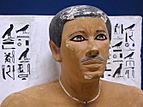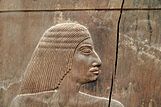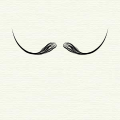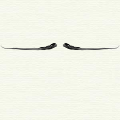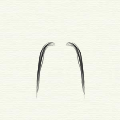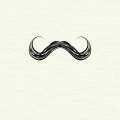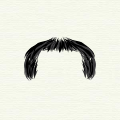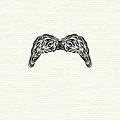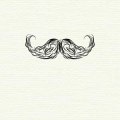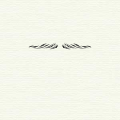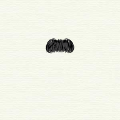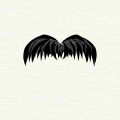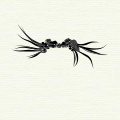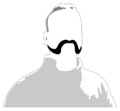Mustache facts for kids

A moustache is the hair that grows on the upper lip of some men. It's different from a beard, which is the hair on the sides of the face and chin. Some men have thick, long moustaches, while others have very little hair. Many men today choose to shave their moustaches or keep them trimmed short. If a man has a beard on his chin but no moustache, it's called a goatee. A beard on the chin with a moustache is known as a Van Dyke.
In the United Kingdom and many Commonwealth countries, the word is spelled "moustache" with an "o".
Some animals, like walruses, also have hair that looks like a moustache, and people sometimes call it that too!
Contents
What is the word "Moustache" from?
The word "moustache" comes from the French word "moustache". This word originally came from an old Greek word, mustax, which meant "upper lip" or "facial hair". It probably came from an even older Greek word, mullon, meaning "lip".
If someone has a moustache, they are often called "moustached" or "moustachioed". The second word is usually used for a very big or bushy moustache!
When did Moustaches become popular?
Moustaches have been around for a very long time! Some of the earliest pictures of moustaches come from Ancient Egypt, way back around 2649–2130 BC.
On the left, you can see a statue of prince Rahotep from the 27th century BC, wearing a moustache.
On the right, there's a picture of Hesy-Ra also from the 27th century BC, with a moustache.
One of the first times we see moustaches worn without a beard was with the Celts during the Iron Age.
Moustaches continued to be worn during the Middle Ages. For example, the famous Sutton Hoo helmet from that time shows a face with a moustache. Later, Welsh leaders and English royalty, like Edward of Wales, often wore only a moustache.
In the Western world, moustaches were most popular in the 1880s and 1890s. This was a time when military styles were very fashionable.
People have been shaving for a long time, even using stone razors in the Stone Age. An ancient Iranian horseman from 300 BC is also shown with a shaved face but a moustache.
In ancient China, people traditionally did not cut their facial hair or the hair on their heads. This was because of the teachings of Confucianism.
What are some Moustache Styles?
There are many different ways to style a moustache! The World Beard and Moustache Championships even have special categories for them. Here are a few popular styles:
- Dalí – This style is narrow and has long, thin ends that curve sharply upwards. The areas past the corners of the mouth must be shaved. Special styling products are usually needed. It's named after the artist Salvador Dalí.
- English moustache – This moustache starts in the middle of the upper lip. The hairs are very long and pulled to the side, curling slightly upwards at the ends. The areas past the corners of the mouth are usually shaved.
- Freestyle – This category is for any moustache that doesn't fit into other specific styles. The hairs can grow a little bit beyond the upper lip, and styling products are allowed.
- Hungarian – This is a big, bushy moustache that starts from the middle of the upper lip and is pulled to the side. The hairs can grow a little bit beyond the upper lip.
- Imperial – This style has whiskers growing from both the upper lip and the cheeks, and they are curled upwards.
- Natural – For this style, the moustache can be shaped without using any styling products.
Other well-known moustache types include:
- Chevron – This style covers the area between the nose and the upper lip, extending to the edges of the upper lip but no further. It was very popular in the 1970s and 1980s. Famous people who wore this style include Freddie Mercury and Tom Selleck.
- Fu Manchu – This moustache has long ends that point downwards, often reaching below the chin.
- Handlebar – This is a bushy moustache with small ends that curl upwards, like the handlebars of a bicycle.
- Horseshoe – This style is often seen on modern cowboys. It's a full moustache with two vertical strips of hair extending from the corners of the lips down to the jawline, making it look like an upside-down horseshoe. It's also called a "biker moustache." Hulk Hogan is famous for wearing this style.
- Pancho Villa – Similar to the Fu Manchu but much thicker and bushier. It's also known as a "droopy moustache."
- Pencil moustache – This moustache is very narrow, straight, and thin, almost like it was drawn on with a pencil. It's closely clipped and outlines the upper lip, with a wide shaved gap between the nose and the moustache. It was popular in the 1940s and is often linked to Clark Gable and the fictional character Gomez Addams.
- Toothbrush – This is a thick moustache that is shaved except for about an inch (2.5 cm) in the very center. Charlie Chaplin and Adolf Hitler wore this style.
- Walrus – This is a very bushy moustache that hangs down over the lips, sometimes completely covering the mouth. Famous people who wore this style include Mark Twain and Albert Einstein.
- Moustache styles
Images for kids
-
Sergey Sergeyevich Kamenev, a Soviet military leader from the 1920s.
-
The Abhinandan moustache, named after Abhinandan Varthaman, an Indian Air Force officer.
See also
 In Spanish: Bigote para niños
In Spanish: Bigote para niños


